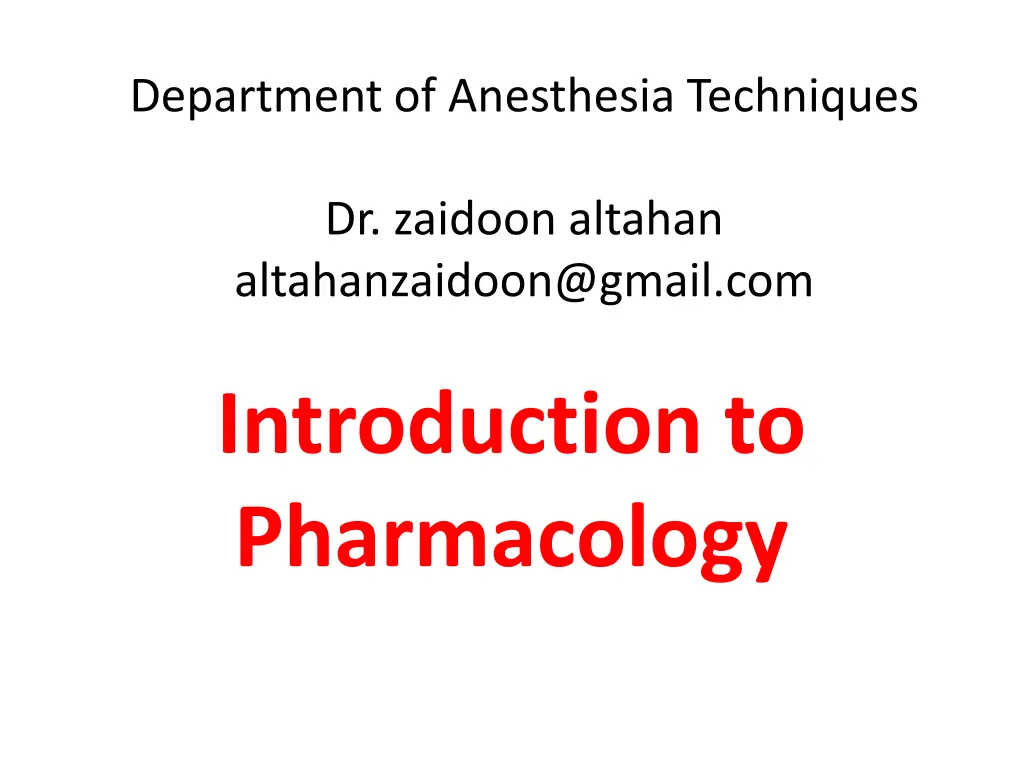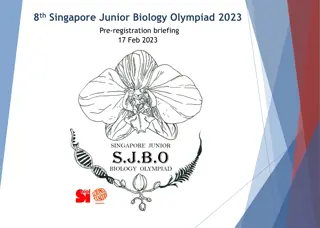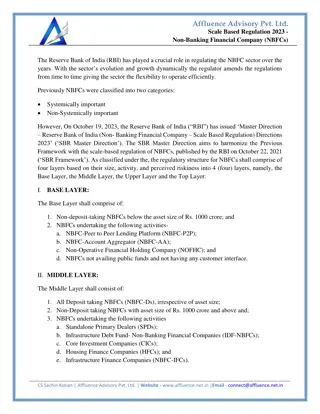
Anesthesia Techniques: Introduction to Pharmacology and Drug Sources
Explore the fundamentals of pharmacology, focusing on the study of drugs interacting with living systems. Discover the principles of pharmacodynamics and pharmacokinetics, sources of drugs from animals, plants, minerals, synthetics, micro-organisms, and genetic engineering. Understand how drugs exert effects through drug-receptor interactions, and learn about potency and efficacy in graded dose-response relationships.
Download Presentation

Please find below an Image/Link to download the presentation.
The content on the website is provided AS IS for your information and personal use only. It may not be sold, licensed, or shared on other websites without obtaining consent from the author. If you encounter any issues during the download, it is possible that the publisher has removed the file from their server.
You are allowed to download the files provided on this website for personal or commercial use, subject to the condition that they are used lawfully. All files are the property of their respective owners.
The content on the website is provided AS IS for your information and personal use only. It may not be sold, licensed, or shared on other websites without obtaining consent from the author.
E N D
Presentation Transcript
Department of Anesthesia Techniques Dr. zaidoon altahan altahanzaidoon@gmail.com Introduction to Pharmacology
Pharmacology is the science of the study of substances that interact with living systems through chemical processes Drugs are chemical substances which affect living organisms and are used by the clinician to diagnose, prevent, or cure diseases.
Pharmacology consist from to main principle 1. Pharmacodynamics: The study of the biological and therapeutic effects of drugs on body (i.e, what the drug does to the body ). 2. Pharmacokinetics: Study of the absorption, distribution, metabolism and excretion. (ADME) of drugs ( i.e what the body does to the drug ).
Sources of Drugs: 1. Animals: Insulin, thyroid extract, heparin. 2. Plants: Morphine, digoxin, atropine, castor oil. 3. Minerals: magnesium sulfate. 4. Synthetic source: Aspirin. 5. Micro-organisms: Penicillin and many other antibiotics. 6. Genetic engineering: Human insulin, human growth hormone etc.
Pharmacodynamics Pharmacodynamics describes the actions of a drug on the body. Most drugs exert effects, both beneficial and harmful, by interacting with specialized target macromolecules called receptors, which are present on or in the cell. The drug-receptor complex initiates alterations in biochemical and/or molecular activity of a cell by a process called signal transduction
the cellular response is proportional to the number of drug-receptor complexes Drug + receptor drug- receptor complex biological effect it is important to know that not all drugs exert effects by interacting with a receptor. Antacids, for instance, chemically neutralize excess gastric acid, thereby reducing stomach upset.
Graded dose-response relationship 1. Potency: is a measure of the amount of drug necessary to produce an effect. The concentration of drug producing 50% of the maximum effect (EC50). 2. Efficacy: is the magnitude of response a drug causes when it interacts with a receptor. Efficacy is dependent on the number of drug-receptor complexes formed and the intrinsic activity of the drug (its ability to activate the receptor and cause a cellular response) Maximal efficacy of a drug (Emax) assumes that the drug occupies all receptors, and no increase in response is observed in response to higher concentrations of drug .
Type of receptors according to efficacy 1. Full agonists If a drug binds to a receptor and produces a maximal biologic response that mimics the response to the endogenous ligand. 2. Partial agonists have intrinsic activities greater than zero but less than one ,Even when all the receptors are occupied, partial agonists cannot produce the same Emax as a full agonist
Antagonists Antagonists bind to a receptor with high affinity but possess zero intrinsic activity. An antagonist has no effect on biological function in the absence of an agonist, but can decrease the effect of an agonist when present. Antagonism may occur either by blocking the drug's ability to bind to the receptor or by blocking its ability to activate the receptor
Type of antagonist recptors 1. Competitive antagonists: If the antagonist binds to the same site on the receptor as the agonist in a reversible manner, example, the antihypertensive drug terazosin competes with the endogenous ligand norepinephrine at a1- adrenoceptors, thus decreasing vascular smooth muscle tone and reducing blood pressure. increasing the concentration of agonist relative to antagonist can overcome this inhibition
2. Irreversible antagonists bind covalently to the active site of the receptor, thereby permanently reducing the number of receptors available to the agonist. 3. Allosteric antagonists: An allosteric antagonist binds to a site (allosteric site) other than the agonist-binding site and prevents receptor activation by the agonist.
4. Functional antagonism: An antagonist may act at a completely separate receptor, initiating effects that are functionally opposite those of the agonist. A classic example is the functional antagonism by epinephrine to histamine-induced bronchoconstriction. Histamine binds to H1 histamine receptors on bronchial smooth muscle, causing bronchoconstriction of the bronchial tree. Epinephrine is an agonist at B2- adrenoceptors on bronchial smooth muscle, which causes the muscles to relax. This functional antagonism is also known as "physiologic antagonism."
Pharmacokinetics Pharmacokinetics refers to what the body does to a drug, 1. Absorption: First, absorption from the site of administration permits entry of the drug (either directly or indirectly) into plasma. 2. Distribution: Second, the drug may reversibly leave the bloodstream and distribute into the interstitial and intracellular fluids. 3. Metabolism: Third, the drug may be biotransformed through metabolism by the liver or other tissues. 4. Elimination: Finally, the drug and its metabolites are eliminated from the body in urine, bile, or feces.
Absorption Absorption is the transfer of a drug from the site of administration to the bloodstream. The rate and extent of absorption depend on the environment where the drug is absorbed, chemical characteristics of the drug, and the route of administration
Mechanisms of absorption of drugs from the Gl tract 1. Passive diffusion: The driving force for passive diffusion of a drug is the concentration gradient across a membrane separating two body compartments. the drug moves from an area of high concentration to one of lower concentration. Passive diffusion does not involve a carrier, is not saturable, and shows low structural specificity. The vast majority of drugs are absorbed by this mechanism. Water-soluble drugs penetrate the cell membrane through aqueous channels or pores lipid-soluble drugs readily move across most biologic membranes due to solubility in the membrane lipid bilayers
2. Facilitated diffusion: Other agents can enter the cell through specialized transmembrane carrier proteins that facilitate the passage of large molecules. These carrier proteins undergo conformational changes, allowing the passage of drugs or endogenous molecules into the interior of cells. This process is known as facilitated diffusion. It does not require energy can be saturated
3. Active transport: This mode of drug entry also involves specific carrier proteins that span the membrane. active transport is energy dependent, driven by the hydrolysis of adenosine triphosphate (ATP). It is capable of moving drugs against a concentration gradient, from a region of low drug concentration to one of higher concentration The process is saturable.
4. Endocytosis and exocytosis: This type of absorption is used to transport drugs of exceptionally large size across the cell membrane. Endocytosis involves engulfment of a drug by the cell membrane and transport into the cell by pinching off the drug-filled vesicle Vitamin B12 is transported across the gut wall by endocytosis. Exocytosis is the reverse of endocytosis. Many cells use exocytosis to secrete substances out of the cell through a similar process of vesicle formation, ex. neurotransmitters norepinephrine are stored in intracellular vesicles in the nerve terminal and released by exocytosis






















